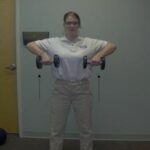What is spasmodic torticollis?
Spasmodic torticollis (ST) is characterized by contractions of the neck muscles that control the movement and position of the head. ST is also referred to its shortened name “torticollis”, and also “cervical dystonia”. ST is caused by a dysfunction in the brain, which causes the head to be pulled backward or to the one side. In many patients, with ST, their heads lie on or near the shoulder. Spasmodic torticollis is very painful and the patient may have tremors of the head and shoulders. The shoulders of the patient may be uneven due to the muscle contractions.
Spasmodic torticollis is not curable and may mimic other disorders such as epilepsy, Parkinson’s disease and muscular dystrophy. The severity of ST is different from person to person, in which the symptoms may be slight or severe to the point of being disabling.
What are the signs and symptoms of spasmodic torticollis?
Spasmodic torticollis presents more commonly in females than in males, and the cause of the disease is unknown. Approximately 5 percent of the patients report having a relative with ST, which indicates there is evidence of a genetic link in a few cases. Family and friends are usually the first ones to notice the symptoms, even before the patient knows there is a problem, because the symptoms are slow to appear. In spasmodic torticollis, the patient appears to have her/his head on crooked, for lack of a better description. The patient may be asked “why is your head leaning to one side?” When the patient tries to straighten her/his neck there will be pain associated on the side where the muscle is contracted.
Spasmodic torticollis comes in three types:
1)
Tonic-the head is turned or leans to one side or is pulled backward.
2)
Clonic-this type involves shaking of the head, and also possibly tremors of the shoulders and arms.
3)
Mixed-this type involves shaking and turning or leaning of the head.
Note: the position of the head (referring to tonic torticollis) may fall into one of four different categories.
1)
Rotational-the head turns and the chin is facing either the left or right shoulder.
2)
Latercollis-the head is pulled down to where the ear is touching or nearly touching the shoulder.
3)
Retrocollis-the head is pulled backward and the chin is facing upward.
4)
Antercollis-the head is pulled downward. the chin is against the chest.
Note: many patients have pulling from a combination of these categories.
How is spasmodic torticollis treated?
Patients are encouraged to lie down 10 minutes every 4 hours on their backs. The clonic movements stop during sleep, and often don’t return for a short time after waking. The spasms in the neck may be temporarily relieved by touching the side of the face or chin.
A small percentage of patients under 40 who have had ST for less than 5 years may recover spontaneously. There is no specific treatment for spasmodic torticollis, but Botox injections paralyze the nerves that contract the muscles, which is a safe and effective treatment that relieves the painful spasms.
Medications-some types of oral seizure medications are prescribed, but they are not effective in relieving the symptoms of ST, but they may be helpful when used in conjunction with the Botox injections. People who have spasmodic torticollis, who are taking dopamine blockers, such as Thorazine, Haldol, Seroquel and other psychotropic drugs should never be given oral medications for ST, because these drugs tend to cause torticollis as a side effect.
Physical therapy-may help the patient gain some range of motion in the neck muscles. The therapist may employ pulling and stretching techniques along with the application of ice to the opposing muscles during the maneuvers.
Deep brain stimulation-involves brain surgery, which involves the placement of electrodes deep within the brain. The wires are connected to an external battery, much like that of a pacemaker. The patient would need to see the doctor on a regular basis to adjust the frequency and power of the electrical stimulus. This is only a treatment and not a cure.
Neurosurgery-is only done as a last resort to sever the nerves that serve the neck muscles. This surgery is called “selective denervation”, and it is difficult for the surgeon to perform this type of surgery.
If you would like more information about spasmodic torticollis, click on the link at the end of this article.
Sources:
National Spasmodic Torticollis Association webpage
Wikipedia


